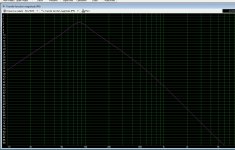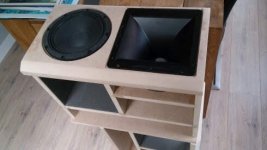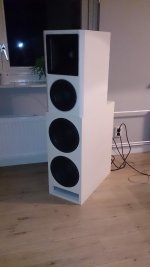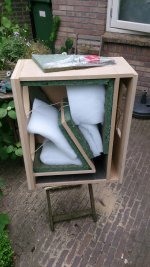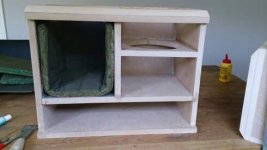Hi all,
A couple of years ago I build active speakers, drivers are Beyma TD365 CD horn + CP755/Ti compression driver, Beyma 8LW30/N midwoofer in 16L closed cabinet and 2x Beyma 10LW30/N woofers (in a tapered transmission line). All are driven by Hypex DSP2.400 plate amplifiers.
Now I am looking into converting the mid section (Beyma 8LW30/N) into a CD design to match the horn. After reading a lot online I found the design by Jag768 (here on the forum) very interesting.
After thinking about it for some time it occured to me that maybe what Jag768 has done with "resistive ports" should also be possible with passive radiators. I did some sims in Boxsim 2.0 with active drivers to get an idea of the transfer function that is needed from the side fireing woofers to get CD down to about 100Hz.
Some very basic sims in WinISD indicates something similar should be possible with Dayton audio DSA270-PR 10'' passive radiators fireing to the sides.
This would be a relatively simple modification, just dusting off the router to make some holes in the sides and re-adjust the DSP.
Any toughts why this would or would not work?
A couple of years ago I build active speakers, drivers are Beyma TD365 CD horn + CP755/Ti compression driver, Beyma 8LW30/N midwoofer in 16L closed cabinet and 2x Beyma 10LW30/N woofers (in a tapered transmission line). All are driven by Hypex DSP2.400 plate amplifiers.
Now I am looking into converting the mid section (Beyma 8LW30/N) into a CD design to match the horn. After reading a lot online I found the design by Jag768 (here on the forum) very interesting.
After thinking about it for some time it occured to me that maybe what Jag768 has done with "resistive ports" should also be possible with passive radiators. I did some sims in Boxsim 2.0 with active drivers to get an idea of the transfer function that is needed from the side fireing woofers to get CD down to about 100Hz.
Some very basic sims in WinISD indicates something similar should be possible with Dayton audio DSA270-PR 10'' passive radiators fireing to the sides.
This would be a relatively simple modification, just dusting off the router to make some holes in the sides and re-adjust the DSP.
Any toughts why this would or would not work?
Yes,
The goal here is not to extend the low frequency response, but that would be a side effect.
The goal is to have a low-passed and out of phase source at the sides, to make the mid section more into a constant directivity setup.
The goal here is not to extend the low frequency response, but that would be a side effect.
The goal is to have a low-passed and out of phase source at the sides, to make the mid section more into a constant directivity setup.
Without having done calculations, my feeling is that the PR will show changing phase behavior in it’s passband around it’s resonance. That is unlike the classical setup with flow resistances. I think a setup with drivers instead of PR’s would be easier to manage, be it with more dsp and amps.
Classic mis-engineering thinking. Reading the latest edition of Toole will make everything clear.
The issue isn't inherently the directivity of the technology (that is, the speakers). The issue is retaining proper tonal balance at the human's ears.
To achieve that tonal balance, you need to consider directivity of each driver and features of the room and the room acoustics. For your room, that's just a matter of achieving a good end result just in your room.
For store-bought systems, you need the elaborate spin-a-rama Toole recommends (measurement of total sound output all around and how much of that is pointed at the listener's chair). That will work optimally in a maximum of settings. That's not important information for sound in your room unless you are kind of obsessive (like a lot of us).
B.
The issue isn't inherently the directivity of the technology (that is, the speakers). The issue is retaining proper tonal balance at the human's ears.
To achieve that tonal balance, you need to consider directivity of each driver and features of the room and the room acoustics. For your room, that's just a matter of achieving a good end result just in your room.
For store-bought systems, you need the elaborate spin-a-rama Toole recommends (measurement of total sound output all around and how much of that is pointed at the listener's chair). That will work optimally in a maximum of settings. That's not important information for sound in your room unless you are kind of obsessive (like a lot of us).
B.
Maybe the goal of proper tonal balance at one’s ear is more easily reached by controlling DI. Applying the right acoustic measures in our living rooms or even in dedicated listening rooms could be more expensive.
Attached the transfer function of the passive radiators when used with the Beyma 8LW30/N
This would - I think - be pretty good to get a more constant directivity out of the midwoofer section.
Have you considered the phase response as well as the magnitude? In an active cardioid there needs to be the right delay to get the desired directivity. That can be either pure delay or delay from a filter.
Passive is harder to do but there have been some passive filter cardioids made.
Passive Unipole - Die Anleitung, Lautsprecher - HIFI-FORUM
Hifi-Zirkel.de • Information
Maybe the goal of proper tonal balance at one’s ear is more easily reached by controlling DI. Applying the right acoustic measures in our living rooms or even in dedicated listening rooms could be more expensive.
Yes, DI is just one tool that is available towards your goal.
As far as the general issue of tonal balance, in many music rooms, the areas of the walls next to the speakers is a key tool and not expensive to address. It's the areas that those who have phantasies about comb filtering are concerned about and for the same geometric reason.
B.
I find the idea of cardioid interesting in the 200 to 500 Hz range where SBIR and placement considerations can make getting a good in room response more difficult.
The room is there whether you like it or not. No feasibly achievable cardioid pattern can control matters sufficiently.
Like the goal of reverb time, I suspect you need comparable amounts of "room sound" across the spectrum.
B.
Like the goal of reverb time, I suspect you need comparable amounts of "room sound" across the spectrum.
B.
Last edited:
I don't disagree but it could play a useful part in an overall strategy particularly if placement and treatment options are more limited.
Avoiding SBIR at the listening position through directivity doesn't have to have a negative impact on overall decay times.
Avoiding SBIR at the listening position through directivity doesn't have to have a negative impact on overall decay times.
Without having done calculations, my feeling is that the PR will show changing phase behavior in it’s passband around it’s resonance. That is unlike the classical setup with flow resistances. I think a setup with drivers instead of PR’s would be easier to manage, be it with more dsp and amps.
Yes, for sure. That would be the way I would do it if I would begin from scratch. Actually it needs just 1 extra DSP + amp channel, not that much more than the current setup (4 channels per speakers). However that is not feasible with the current speakers, that would require a completely new build. Maybe something to do in a couple of years.
Have you considered the phase response as well as the magnitude? In an active cardioid there needs to be the right delay to get the desired directivity. That can be either pure delay or delay from a filter.
Passive is harder to do but there have been some passive filter cardioids made.
Passive Unipole - Die Anleitung, Lautsprecher - HIFI-FORUM
Hifi-Zirkel.de • Information
I'll take a look at those links, my German is a bit rusty, Google can probably help..
I did sims with an active cardiod in Boxsim 2.0. It looks like I can get up to about 6 - 7dB DI with active woofers fireing to the sides, just passively low-passed (the driver pointing to the listener not being passively filtered, all DSP, so using the same amp). That's how I arrived at the idea of using PR's. That and the work done by Jag768 and the beautiful design by D&D (the 8C).
It's the all pass delay from the low pass filter that works in a similar way to the acoustic delay in the resistive ports to cause the side sound to cancel the front sound at the right time to get the pattern. The cardioid effect is greatest when the delay matches the path length difference between front and side sources.
My German is non-existent so I just use Chrome to translate which usually gets me through.
My German is non-existent so I just use Chrome to translate which usually gets me through.
Some images of the speakers during construction, and when I just finished them.
As you can see, there is some room for mods.
As you can see, there is some room for mods.
Attachments
Last edited:
In Germany there actually is quite an active scene, to be found at DIY-HIFI-Forum, amongst other places. Probably why there are less German native speakers around here. But I could try to be of assistance, while my German isn't stellar, I do understand the audio part of it.I'll take a look at those links, my German is a bit rusty, Google can probably help..
I do to, actually I live about 15km south of you, also very close to the border, in the oldest city of the Netherlands.
But as you can probably recognize, I use English @ work and Dutch @ home, almost no need to use German at all, hence a bit rusty 😛
Just high school and university (HTS) lessons to fall back on.
Actually started watching some German TV shows recently (how to sell drugs online fast among others) on Netflix, fun show and good to brush up on my German.
But as you can probably recognize, I use English @ work and Dutch @ home, almost no need to use German at all, hence a bit rusty 😛
Just high school and university (HTS) lessons to fall back on.
Actually started watching some German TV shows recently (how to sell drugs online fast among others) on Netflix, fun show and good to brush up on my German.
Last edited:
Different kind of port...with "resistive ports" should also be possible with passive radiators.
Unless you have a plan to make the passive radiator more resistive and less resonant?
- Home
- Loudspeakers
- Multi-Way
- Modifying speaker to constant directivity
